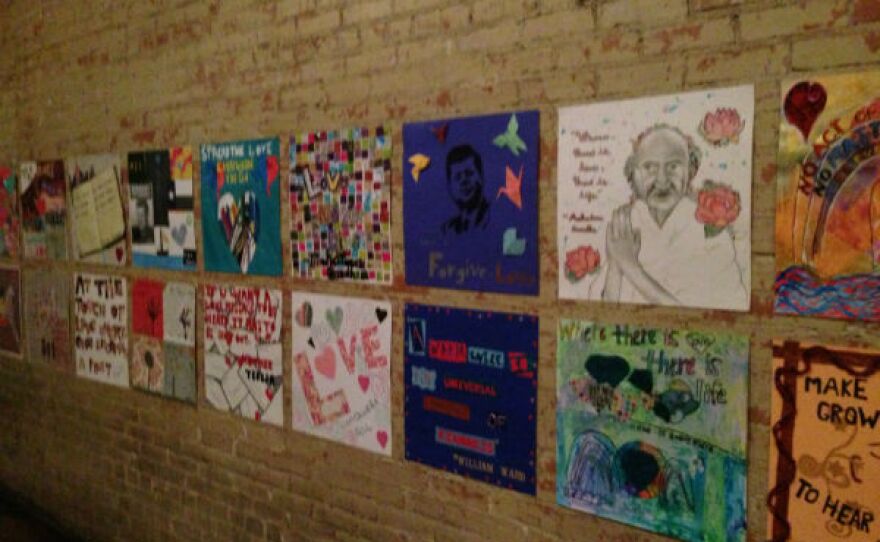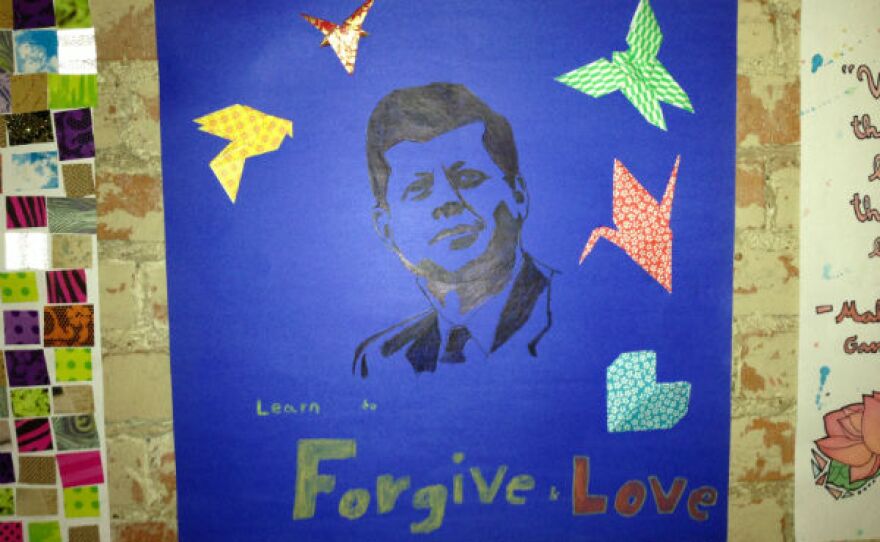Throughout November, KERA will mark the 50th anniversary of the John F. Kennedy assassination by taking a closer look at that fateful day, what it meant to the country, how it changed Dallas, and more.
Today, we take a look at a citywide effort to turn the ‘City of Hate’ into the ‘City of Love’ through art. KERA’s Jerome Weeks has the story:
Almost immediately after President Kennedy was shot in Dealey Plaza on Nov. 22, 1963, Dallas was labeled the City of Hate.
The label stuck.
Debbie Landa is the co-owner of a Dallas gallery. She recalls moving here in 1965. Friends were horrified. They told her: “Oh, that’s a horrible city. They killed Kennedy.”
Artist Karen Blessen wants to overturn that label. She and her organization, 29 Pieces, developed the Dallas Love Project. She’s gotten more than 50 schools, businesses and arts groups to help make poster-sized artworks, some 20,000 of them. Each features a quotation about love from such figures as Martin Luther King. They’ve been put up in storefront windows and on lawns along the route Kennedy’s motorcade took from Love Field to downtown Dallas — Mockingbird to Lemmon Avenue to Turtle Creek/Cedar Springs to Elm.
The project’s goal, Blessen says, is “to get this message out into the world that, while Dallas may have been given this label as a city of hate, that just isn’t accurate. There are many people here who embody all the high qualities of a human being.”
Love throughout the city
On the night before Nov. 22, 1963, flyers appeared around town. Designed like “wanted posters,” they accused Kennedy of treason.
“Thousands were posted all over Dallas,” Blessen said.
She says that if the Love Project had a particular inspiration it was this: to cover the city with 20,000 messages that counter that flyer.
Blessen and her partners contacted storeowners and coordinating students, volunteers and professional artists to help track where each artwork will go. The project has more than enough artworks to cover the motorcade route. The rest are being exhibited in about a dozen other locations all over the city.
But will these grassroots messages really have any effect — on Dallas or on Dallasites? Blessen believes they will. Twenty thousand messages of love throughout a city? It’s like advertising, she says.
Finding peace through the Love project
Greg Colgan works for an aviation consulting firm. He and his wife volunteered to create artworks for the Love Project. They spent six hours listening to Blessen and thinking about messages of peace and love. Colgan says it was like a meditational exercise, taking time out from one’s hectic life to consider something more than the next email.
Initially, Colgan says he was nervous. “Between art and meditation and sacred passages, I just consider myself ignorant. That was the interesting experience — is pushing myself out of my comfort zone. And coming out of that, you know, as corny as it sounds, to find a little bit of peace.”
Want to know more about how Dallas got its “City of Hate” nickname? Read more from KERA’s Jerome Weeks on Art&Seek.
KERA wants to hear your JFK stories and memories. Email us at jfk@kera.org. We may contact you or use your memory in an upcoming story.











